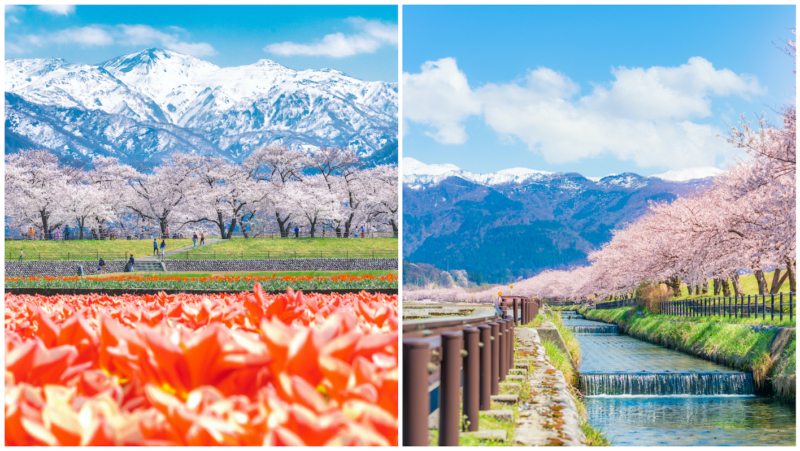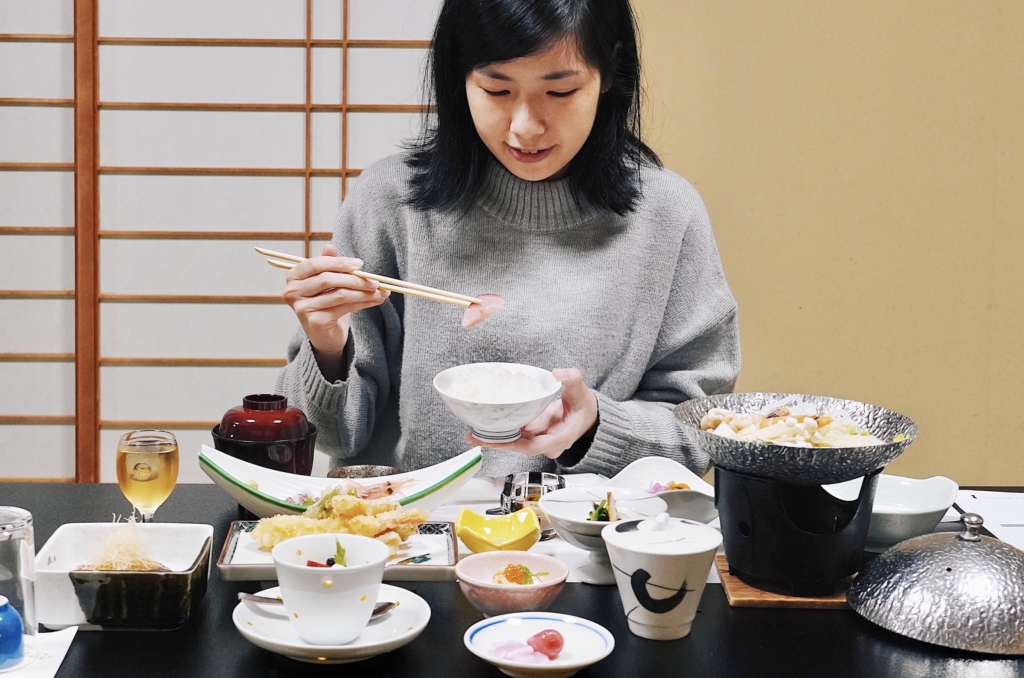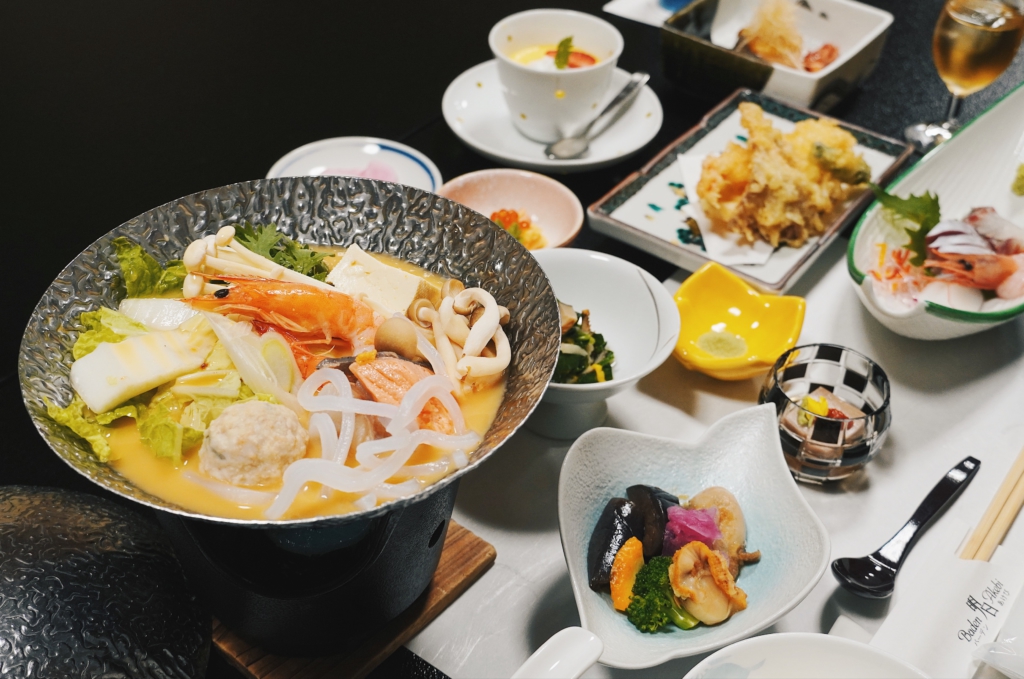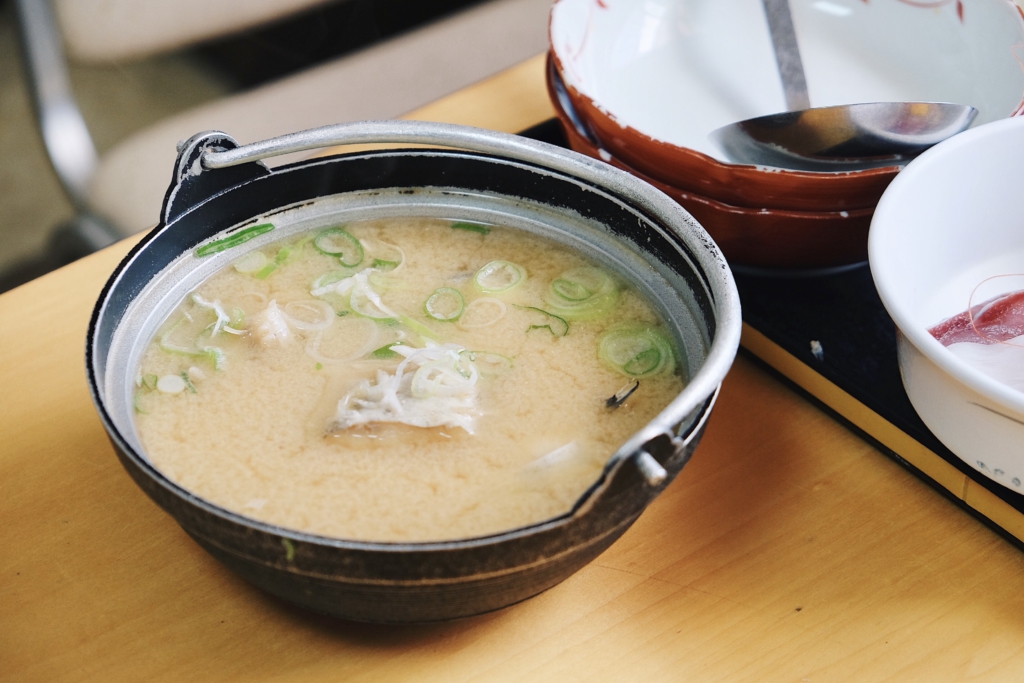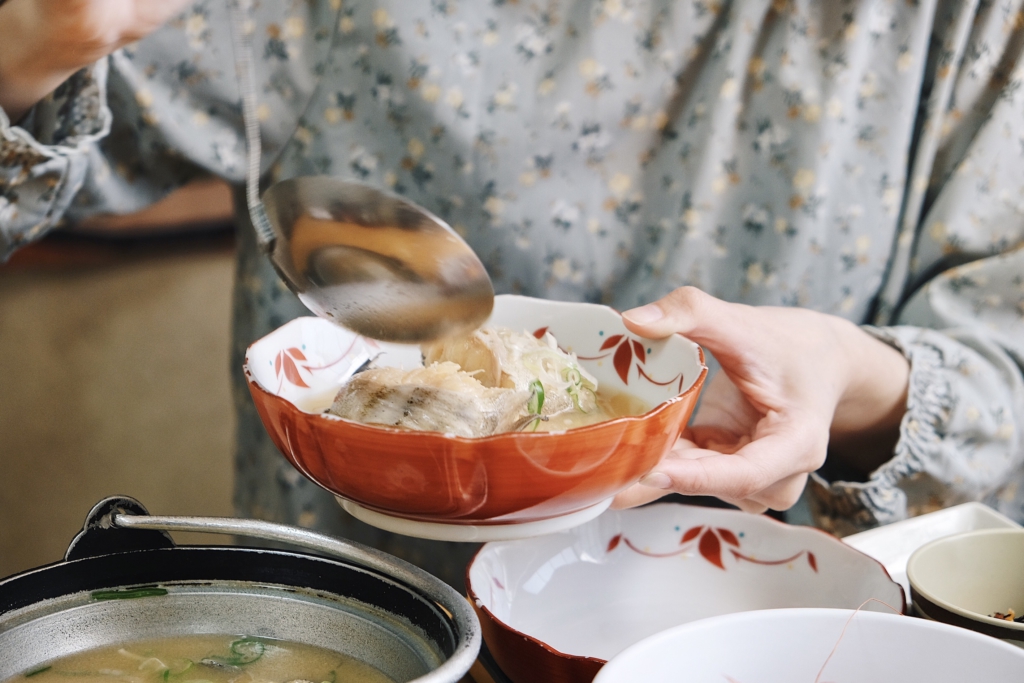Toyama is a prefecture of Japan with many gorgeous views, including the renowned Tateyama Kurobe Alpine Route. Most noteworthy are the flowers of spring, which weave together an enchanting, romantic atmosphere. One pleasant weekend, we boarded the shinkansen (bullet train) to the Niikawa region of eastern Toyama and explored the two beautiful regional towns of Nyuzen and Asahi via rental car. In Nyuzen, we visited the Nyuzen Flower Road with its breathtaking mountainous backdrop along with the lush “Sugisawa-no-Sawasugi” Japanese sawasugi cedar forest. In Asahi, we partook in flower viewing at the famous Spring Quartet and visited an old Japanese homestead to discover the traditional local tea culture. Join us as we thoroughly relish the bounties of Toyama through this springtime adventure!
*This article was written in collaboration with the Toyama Bay, Kurobe Gorge, Etchu Niikawa Tourism Zone Council.
The Niikawa Region: Nyuzen, Asahi, Uozu, and Kurobe

The Niikawa region of eastern Toyama Prefecture is a vast sightseeing district consisting of two towns and two cities: Nyuzen Town, Asahi Town, Uozu City, and Kurobe City. From 3,000-meter-high mountains to the pristine waters of the Kurobe River and the rich, mysterious seas of Toyama Bay, the diverse local geography of Niikawa yields a stunning array of natural wonders to enjoy.
Getting to Toyama
Toyama, located in the Hokuriku region of Japan, has both airport and bullet train access, so it can be easily visited from other Japanese cities along with countries like Taiwan, Korea, and China. Using the bullet train from Tokyo will take you to Toyama in around 2.5 hours.
Getting to Toyama Via Airplane

・Tokyo Haneda Airport to Toyama Kitokito Airport: Approx. 1 hr
*Exact flight details are subject to change due to COVID-19. Please confirm the details at each airline’s official website.
*Toyama Kitokito Airport Flight Information (ENG): https://www.toyama-airport.jp/en/flight.html
Getting to Toyama Via Bullet Train

・From Tokyo Station to Kurobe-Unazukionsen Station via the Hokuriku Shinkansen: Approx. 2 hrs 20 mins, 12,000 yen/person.
・From JR West Shin-Osaka Station to Kanazawa Station via the Limited-Express Thunderbird, then to Kurobe-Unazukionsen Station via the Hokuriku Shinkansen: Approx. 3 hrs 30 mins, 10,000 yen/person.

*There are several rental car companies within a 3-minute walking distance from Kurobe-Unazukionsen Station, allowing you to rent a car as soon as you disembark.
Trip Schedule
Day 1: Nyuzen
Cherry Blossoms by Kurobe River: A Pink Arch Over Pristine Water

The Kurobe River is known for its abundance of fresh, clear water, and the water that stems from its alluvial fan was specially selected as one of Japan’s Top 100 Waters. Through the collaborative efforts of the local townspeople, 70 Yoshino cherry trees were planted by the river embankment, which has since flourished into a 1.2 km road of 170 trees in the 50+ years since. The spectacular Tateyama Mountain Range in the background alongside the pink flower arch drawn on the surface of the river forms a sight you surely won’t forget. Under the clear sky, the whimsical rural scenery complemented by the whispering of flowing water and the sweeping curtain of faint pink cherry blossoms is reminiscent of a poem or painting, naturally beckoning all those who visit to lose themselves in this untainted beauty.
| Name: | Cherry Blossoms by Kurobe River |
|---|---|
| Address: | Urayama-shin, Nyuzen-machi 入善町浦山新 Google Maps |
| Website (Japanese): | http://www.nyuzen-kanko.jp/miru/4310/ |
| Other: | Please confirm the latest cherry blossom viewing period on the official website. |
Nyuzen Flower Road: A Colorful Carpet of Tulips as Far as the Eye Can See!

Home to one of Japan’s largest tulip events, it’s no exaggeration to say that tulips are one of Nyuzen’s most iconic symbols. Started in 1991 and having celebrated its 25th iteration in 2021, the Nyuzen Flower Road is a magnificent local festival held every year. Backed by clear skies and the snow-topped Northern Alps, roughly 8 hectares of flower fields boasting 3 million tulips of 100 different varieties bloom at once. This blankets the area in a brilliant natural carpet made up of stark reds, yellows, oranges, pinks, and more!


The Nyuzen Flower Road is held at a different location each year and the best time to see it is between early to late April. You’ll be able to witness a staggering range of different sights depending on the location, day, and time. If you step into the fields to take a picture, you’ll feel like you’re in a painting. In addition to the scenery, you can also purchase new varieties of tulips cultivated in Nyuzen at the flower shop, enjoy food and drink at the pop-up booths, try your hand at making a bouquet, and more. Leisurely strolling amongst the dazzling scenery while snapping plenty of photos will make your Toyama travel memories even more special!
| Name: | Nyuzen Flower Road |
|---|---|
| Address: | The location of the Nyuzen Flower Road differs each year. Please check the location on the official website. |
| Website (Japanese): | https://www.town.nyuzen.toyama.jp/flowerroad/index.html |
Sugisawa-no-Sawasugi/Sawasugi Nature Museum: A Dense Marsh of Cedars Facing the Sea

Another one of Nyuzen’s most famous destinations is this mysterious marshy forest. Within the coastal region of the Kurobe River basin, where the subterranean water gushes from the ground, lies a prospering natural Japanese cedar forest called “sawasugi” (literally “marsh Japanese cedar”) making up the Sugisawa area. Roughly 50 years ago, the massive sawasugi forest reached up to 45 hectares. However, a large part of it was logged, leaving only 2.7 hectares today that are now designated as a natural monument of Japan.

Outside the Nature Museum is a boardwalk through the Sugisawa area, allowing one to explore the mystical environment of streams, ponds, and moss-covered trees while checking out the sawasugi cedar trees up close. Some defining characteristics of sawasugi cedars that you may notice are the way the branches of the young trees touch the ground due to the weight of the snow and the unique horizontal growth of the roots. The warmth of Nyuzen’s winter has nurtured a diverse ecosystem of animals and plants, making one feel as if they’ve ventured deep into the mountains despite it being right next to the coast of Toyama Bay.


Within the museum are detailed exhibits along with an indoor observation platform with views of the surrounding scenery. Definitely be sure to check out the spring at the back of the museum to enjoy a taste of Kurobe River’s refreshing water.
| Name: | Sugisawa-no-Sawasugi/Sawasugi Nature Museum |
|---|---|
| Opening Hours: | 9:00 AM – 5:00 PM (last entry 4:30 PM) |
| Price: | Free |
| Address: | 950, Yoshiwara, Nyuzen-machi, Shimoniikawa-gun, Toyama 富山県下新川郡入善町吉原950番地 Google Maps |
| Closed: | Mondays (next day if national holiday), days following national holidays, winter closure period (December 28 – end of February) |
| Website (Japanese): | http://www.nyuzen-kanko.jp/miru/264/ |
Nyuzen Deepsea Water Park: Home to One of Japan’s Most Renowned Waters

Nyuzen, facing the Sea of Japan to the north and having the Kurobe River running through it, is nicknamed the “town of famous water.” Many brands and companies in the food industry have used this water to prosper, creating products such as “Koshihikari” rice, Nyuzen jumbo watermelons, and tulip bulbs. In recent years, Nyuzen has also added deep ocean water to its list of resources, with the “Japan Sea Proper Water” pumped up from a depth of 384 m roughly 3 km offshore. This water has been naturally kept at a stable low temperature (approx. 1-2°C all year) and is exceptionally clean and packed with nutrients and minerals.

Along with its role as a water supply facility, Nyuzen Deepsea Water Park offers detailed explanations on how they pump up the water along with a wide display of products utilizing this resource, such as cosmetics, skincare products, foodstuffs, condiments, bathing supplies, and more. In front of the facility, you can also sample three different kinds of water – super-salty 5% concentrated water, 3% deep ocean water, and desalinated water.
| Name: | Nyuzen Deepsea Water Park |
|---|---|
| Opening Hours: | 9:00 AM – 5:00 PM |
| Closed: | Mondays (next day if national holiday), New Year’s period (December 29 – January 3) |
| Price: | Free |
| Address: | 251-1, Shimoiino, Nyuzen-machi, Shimoniikawa-gun, Toyama 富山県下新川郡入善町下飯野251番地1 Google Maps |
| Website (Japanese): | http://www.nyuzen-kanko.jp/asobu_manabu/585/ |
Nyuzen Kakinohoshi: Relish the Sweetness of Seasonal Seafood Purified By Deep Ocean Water

Next door to the Deepsea Water Park is Nyuzen Kakinohoshi, where you can relish fresh ocean bounties purified by deep sea water. As soon as you enter, you’ll immediately be captivated by the giant fish tank filled with deep sea water holding oysters, abalone, clams, and more. Each serving is taken from the tank upon receiving an order, guaranteeing peak freshness.

The raw oysters were thick, fleshy, and bursting with umami flavors. They felt soft and smooth and filled our mouths with the smell of the ocean. When roasting the oysters, the staff will help you cook them to perfection. Of course, each serving of oyster is always presented in its peak condition, with a range of additional dishes utilizing their flavors like seasoned cooked “takikomi” rice and miso soup, allowing oyster lovers to fully satisfy themselves. Whether they be raw, steamed, grilled, or deep fried, the intrinsic essence of oyster is thoroughly displayed in every possible way here.
| Name: | Nyuzen Kakinohoshi |
|---|---|
| Opening Hours: | [Weekdays] 11:00 AM – 5:00 PM (last order 4:00 PM) [Weekends/National Holidays] 10:00 AM – 6:00 PM (last order 5:00 PM) |
| Closed: | Open all year (except New Year’s) |
| Price: | Kakinohoshi Set: 3,500 yen All-You-Can-Eat Grilled and Steamed Oysters Set (90 min system): 4,900 yen/person |
| Address: | Inside Nyuzen Deepsea Water Park, 251-1, Shimoiino, Nyuzen-machi, Shimoniikawa-gun, Toyama 富山県下新川郡入善町下飯野 251-1 海洋深層水パーク内 Google Maps |
| Website (Japanese): | https://www.kakinohoshi.com/nyuzen/restaurant.php |
Nizayama Forest Art Museum: Contemporary Art in a Historic Building

This splendid red brick building stands encompassed by the rural scenery of Toyama. It originally served as a hydroelectric power plant between 1926 and 1992 before being repurposed for art. While the deteriorating power plant originally faced dismantlement, it was given new life as a place to display modern artistic talents within a rustic interior, with the water pipe and turbine remaining in their original state.

The inside is open and spacious, with a 10-meter-tall ceiling and an exposed steel frame displaying traces of its original character. This unique space stimulates the creative urges of artists, and there are currently exhibitions focused on large three-dimensional works created on-site along with installations taking over the entire venue. Each time you visit, you’ll likely encounter creations of a brand new theme you’ve never seen before! Additional facilities like a coffee shop can also be found at the top of the river terrace at the back of the museum via the outside stairs. Looking down over the building which blends in with the surrounding nature fills one with a calming sense of serenity.
| Name: | Nizayama Forest Art Museum |
|---|---|
| Opening Hours: | 9:00 AM – 5:00 PM (last entry 4:30 PM) Opening and closing times may change depending on the exhibition. |
| Closed: | Mondays, days following national holidays (if Monday is a national holiday, the facility will be closed the following Tuesday), during exhibition changes (may close from several weeks to several months), during the winter period (mid-December – end of February). |
| Price: | [Special Exhibitions] General: 600 yen, University/high school: 300 yen, Middle school or younger: free |
| Address: | 364-1, Nizayama, Nyuzen-machi, Shimoniikawa-gun, Toyama 富山県下新川郡入善町下山364-1 Google Maps |
| Website (Japanese): | https://www.town.nyuzen.toyama.jp/gyosei/bijutsukan/index.html |
| Other: | As the facility is only open during exhibitions, the opening sessions and fees may change each year. |
Recommended Accommodations
Baden Akebi: A Spacious Outdoor Bath in a Japanese Garden in Nyuzen


Situated in the mountains, Baden Akebi is surrounded by the clear waters of the Kurobe River and tranquil greenery. It prides itself foremost on its gardenside outdoor bath boasting amazing mountain views and a giant stone lamp that give it a Japanese atmosphere. Guests get to admire the beauty of Nyuzen during each of the four seasons while soaking in this spacious, open bath. The water comes from deep in the mountains along the Kurobe River. This water is clear and will leave your body with a lingering warmth and exceptionally smooth skin, leading to its loving nickname “nature’s lotion.”
Complementing the hot springs are meals served with warm hospitality, including dinner which is centered around Japanese “kaiseki” course cuisine boasting seasonal delicacies and seafood assortments filled with flavor. This includes a lineup of unforgettable dishes like Japanese amberjack grilled with yuzu miso paste, “chawanmushi” egg custard with crab, and vinegared oysters and scallops. There is also an additional option to enjoy your food with a tasting set of three different local brews of sake. Breakfast was an equally noteworthy selection of seafood delights, serving to wake up our taste buds and ready us for the second day of sightseeing.
| Name: | Baden Akebi |
|---|---|
| Check in: | 3:00 PM |
| Check out: | 10:00 AM |
| Address: | 1677-1, Funami, Nyuzen-machi, Shimoniikawa-gun, Toyama 下新川郡入善町舟見1677-1 Google Maps |
| Website (Japanese): | http://www.baden-akebi.jp/ |
| Other: | Day visitor bathing time: 10:00 AM – 9:00 PM Reception: 9:30 AM – 8:00 PM Adult (Middle school and above): 550 yen Child (3+): 400 yen |
Hotel Ogawa: A Natural Hot Spring Cave in Asahi

If you truly want to experience the best of Japan’s hidden hot spring culture, then we recommend spending the night at Hotel Ogawa in Asahi. Appearing as soon as you leave Asahi Ogawa Tunnel, Hotel Ogawa sits beside a valley and boasts over 400 years of history. It is adored for its hot spring waters that are said to promote fertility and heal the body.

The splendid natural cave bath, located eight minutes on foot from the hotel, is famous within Asahi. It was formed by the buildup and solidification of mineral deposits from the hot spring waters over the years. By soaking in the spring while taking in the soothing background noise of rippling water, you’ll feel yourself become one with the encompassing nature, allowing deep insight into its beauty.

This beauty also extends to the hotel lobby, which offers views that perfectly capture the colors of each season from giant floor-to-ceiling windows. After finishing your bath, we recommend sitting here with a warm drink to further nourish your mind and body.
| Name: | Hotel Ogawa |
|---|---|
| Check in: | 3:00 PM |
| Check out: | 10:00 AM |
| Address: | 1, Yunose, Asahi-machi, Shimoniikawa-gun, Toyama 富山県下新川郡朝日町湯ノ瀬1 Google Maps |
| Website (Japanese): | https://www.ogawaonsen.co.jp/ |
| Other: | A free shuttle bus service is available to and from Kurobe-Unazukionsen Station on the JR Hokuriku Shinkansen. Advanced reservation is required. Please confirm the timetable here: https://www.ogawaonsen.co.jp/access/ |
Day 2: Asahi
Asahi Funakawa Spring Quartet: A Harmony of Mountains, Cherry Blossoms, Tulips, and Nanohana

The township of Asahi is located on the border of Toyama and Niigata Prefectures. It’s blessed by a profound history and deep culture, and is nestled within a staggering diversity of terrain ranging from the Hisui Coast sitting at sea level to the 3,000-meter-high Northern Alps peaks of Mt. Asahi and Mt. Shirouma.
The banks of the Funakawa River, which flows through the western side of Asahi, are roughly 600 meters long. Here around 280 Yoshino cherry trees, which were planted by local residents when working on the river, burst into a radiant tunnel of pink during spring, delighting the locals and attracting flocks of both domestic and international visitors.

Blooming at the same time are 600,000 dazzling tulips alongside an ocean of golden “nanohana” rapeseed flowers. Backed by the snow-capped Mt. Asahi and Mt. Shirouma, as well as the other peaks of the Northern Alps, the pink cherry blossoms, red tulips, yellow nanohana, and white mountains combine to form the “Spring Quartet,” which appears every year between early to mid-April. During this period, a temporary bus service will help ferry visitors from locations such as Tomari Station on the Ainokaze Toyama Railway.

You’ll hardly be able to peel your eyes away from the spellbinding glow of colorful flowers augmented by the warm blue skies and puffy white clouds. These views become even more intense as the evening sun casts a warm angled glow over the cherry blossoms. Even at night, the trees are lit up in an enchanting, romantic display, forming an entirely different atmosphere from the daytime. Rediscovering this beauty again and again as it changes throughout the day and night is sure to be an amazing experience for any visitor.
| Name: | Asahi Funakawa Spring Quartet |
|---|---|
| Opening Hours: | Peak viewing time is from early to mid-April *The flower blooming period differs each year. Please confirm the latest peak viewing time on the official website. |
| Address: | Funagawa-shin, Asahi-machi, Shimoniikawa-gun, Toyama 富山県下新川郡朝日町舟川新 Google Maps |
| Website (Japanese): | https://www.asahi-tabi.com/sijuusou/ |
Former Kawakami Residence: Discover Bata-Bata Tea Culture in a Traditional Japanese Home

Bata-bata tea is a traditional custom that thrived in the Birudani area of Asahi. Long ago, after finishing their jobs early in the morning, villagers would prepare a dish of boiled homegrown vegetables along with pickles to eat and chat while drinking tea. In addition to this everyday routine, local weddings, births, and other events that brought people together would see the appearance of bata-bata tea. Even today, this tea custom plays an essential role in deepening the connection between residents, acting as the cornerstone of mountain village communication and intermingling.

Bata-bata tea is a kind of fermented black tea that originally came from China. The tea leaves are heated and dried before being rubbed and left out to dry in the sun. They are then restacked and made to ferment for around 40 days, yielding a deep color and rich taste. When making the tea, you stir it by moving your arm, leading to the name “bata-bata” coming from the sound of the tea whisk hitting the sides of the teacup.

The Former Kawakami Residence, which now sits within Asahi Town Historical Park, was originally constructed in a post town during the middle of the Edo period (1603-1868) and is said to be the oldest townhouse in the prefecture. After being dismantled and restored, it was moved to its current location to serve as a place to experience the art of bata-bata tea.
| Name: | Former Kawakami House |
|---|---|
| Opening Hours: | 9:00 AM – 3:00 PM |
| Closed: | Wednesdays, Sundays, winter closure period (late December – mid-March) |
| Price: | Free |
| Address: | 302-1, Yokomizu, Asahi-machi, Shimoniikawa-gun, Toyama 富山県下新川郡朝日町横水302-1 Google Maps |
| Website (Japanese): | https://www.asahi-tabi.com/asahimachi/249/ |
Hisui Coast: Search For Precious Jade!

The Miyazaki-Sakai Coast, a 4 km stretch of gravelly coastline, is also known as the “Hisui Coast” or “Jade Coast” due to the waves washing up unpolished jade gemstones onto the shore. In fact, the coasts of Asahi and nearby Itoigawa in the neighboring Niigata Prefecture are the only places in Japan where you can find unpolished gemstones like this. Being incredibly famous, there are always people visiting these locations hoping to come across some jade.


Asahi was said to have produced gemstones between the Jomon period and Kofun period. Nowadays, you can learn from an expert guide on how to find and distinguish jade before heading out to the shore to search for some.

In recent years, the newly established seaside Hisui Terrace acts as a sightseeing hub for the area while providing fantastic views overlooking the deep blue of the Sea of Japan from its rooftop terrace. The interior is bright and clean, with experienced guides who will run you through the various types and shapes of gemstones and teach you the trick to telling them apart from regular stones. After learning from them, you’ll head out to the beach together to begin your treasure hunt!
If you can stay late, you’ll also be able to enjoy a stunning coastal view of the evening sunset.
| Name: | Hisui Terrace |
|---|---|
| Opening Hours: | 8:30 AM – 5:30 PM *Winter period (November-March): until 4:00 PM |
| Closed: | December 29 – January 3 |
| Address: | 3239-6, Miyazaki, Asahi-machi, Shimoniikawa-gun, Toyama 富山県下新川郡朝日町宮崎3239番地6 Google Maps |
| Website (Japanese): | https://www.info-toyama.com/spot/51009/ |
| Other: | Guided Plan (Mizumeguri Hisui Kirarin, Seafood Course) https://www.asahi-tabi.com/asahimachi/90/ Held: April – November ①9:30 AM – 12:30 PM ②12:00 PM – 3:00 PM Venue: Meet at Hisui Terrace Fee: 5,000 yen/person (excl. tax) (includes guide, lunch, and insurance) *Please reserve at least 7 days before you intend to visit either online or via telephone. *Guides can only communicate in Japanese. |
Drive In Kinkai: Enjoy Cod Soup, A Dish Beloved by the Local Fishermen

The specialty dish of Asahi is “tarajiru” cod soup: a warm, highly nutritious soup originally made long ago by the wives of fishermen on the shore as they waited for their husband’s return. Walleye pollock, a species of cod, are caught in abundance here, naturally leading to outlets serving the dish popping up everywhere. In fact, the area around Etchu-Miyazaki Station (Ainokaze Toyama Railway) on National Route 8 is nicknamed the “cod soup highway,” and there are loads of guesthouses and restaurants around there selling the dish all year round. Drive In Kinkai boasts fresh and sweet cod soup, as well as seafood directly sourced from the local fish market alongside other seasonal dishes. The 1st floor is a dining hall popular with locals and long-distance drivers, while the 2nd floor hosts accommodations.
| Name: | Drive In Kinkai |
|---|---|
| Opening Hours: | 9:00 AM – 10:00 PM |
| Closed: | 2 times per month (Thursdays), irregular closures |
| Price: | Cod Soup Set: 1,400 yen (incl. tax) |
| Address: | 25-1, Sakai, Asahi-machi, Shimoniikawa-gun, Toyama 富山県下新川郡朝日町境25-1 Google Maps |
| Website (Japanese): | https://www.asahi-tabi.com/asahimachi/352/ |
The Perfect Souvenir! 100% Glass Shrimp Senbei: The Bounties of Toyama Bay Pressed Into a Cracker

Glass shrimp, which can only be caught in Toyama Bay, are considered the jewel of the region. They are characterized by a white, almost transparent body with a faint aroma. Together with mineral-rich deep ocean water from the Sea of Japan, these shrimp are lightly roasted into 100% glass shrimp “senbei” shrimp crackers. Not only is the intrinsic flavor of the glass shrimp maximized, but the tantalizing aroma and crisp, light bite will have you eating away until the entire box is gone! For those looking to bring home the flavors of Toyama Bay, you can’t go wrong with this!
| Name: | 100% Glass Shrimp Senbei (Kaisendou) |
|---|---|
| Price: | 6 (box): 350 yen 15 (packet): 640 yen 18 (box): 800 yen 24 (box): 1,000 yen 36 (box): 1,500 yen |
| Website (Japanese): | http://www.aiba-t.co.jp/senbei.html |
| Available At: | On sale at souvenir shops or at accommodations like Baden Akebi, etc. |
Map of the Locations We Visited in Nyuzen and Asahi
A Springtime Adventure Amongst Blooming Flowers in Nyuzen and Asahi
This article detailed our relaxing 1 night, 2-day springtime road trip around Nyuzen and Asahi. With a multitude of fun, invigorating experiences like witnessing flower fields backed by blue skies and mountains, bathing in uniquely shaped natural hot springs, discovering the local tea culture, and chowing down on plump grilled oysters, both our hearts and bodies were deeply satisfied. We highly recommend making your way through the incredible Nyuzen and Asahi areas on your next Japan spring road trip!
In addition to Nyuzen and Asahi, don’t miss out on visiting the equally fantastic Kurobe and Uozu areas of the Niikawa region.
Check out the article here: Fall Bliss in Toyama: A Weekend Road Trip in Kurobe and Uozu
*The information presented in this article is accurate as of the time of publication.
The information in this article is accurate at the time of publication.
